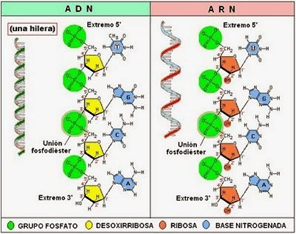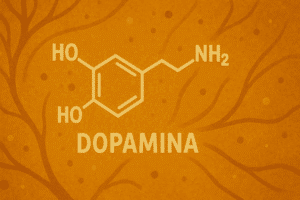Both RNA and DNA are part of the group of nucleic acids. Nucleic acids are polymers (substances made up of large molecules) formed by the binding of subunits called nucleotides (the "little letters" that make up DNA or RNA). The main difference between DNA and the RNA is his chemical composition.
DNA is a polymer made up of nucleotides whose pentose (type of sugar) is deoxyribose (deoxyribonucleotides) and its nitrogenous bases (compounds with hydrogen) are adenines (A), guanines (G), cytosines (C) and thymines (T). Whereas DNA is a polymer formed by ribonucleotides whose main nitrogenous bases are A, G, C and uracils (U) linked by phosphodiester bonds.

Types of RNA according to structure and function
In most organisms, including humans, the function of RNA is to copy the information from DNA in such a way that it can be expressed in proteins, the functional elements of our organism. However, there are cases in which RNA fulfills the function of DNA because certain organisms, such as some viruses, lack DNA and encode their biological information in RNA.
It is important to remember the complementarity that exists in nucleic acids. When we talk about DNA, the nitrogenous base complementary to A is T and complementary to C is G and vice versa. However, if we speak of complementarity between DNA and RNA, it is slightly modified since the complementary base to A is U and not T as was previously the case.
Thanks to this complementarity, it is possible for the cell to maintain the same genetic information regardless of the molecule used to express it: DNA or RNA. We can say that the copies of the genetic information are always made maintaining this complementarity so that we will have the same information in this DNA fragment:
5´ TAC GCA TGG 3 '
That in this RNA fragment:
5´ AUG CGU ACC 3 '
Depending on the structure and specific function performed by each RNA, there are different types of RNA:
- Messenger RNA (mRNA):linear structure with some hairpin loops. It is synthesized in the cell nucleus from DNA. It is the result of the transcription process. Its function is to copy fragments of DNA to take this information out of the nucleus and carry it to the ribosomes where the genetic information will be converted into proteins (translation).
- Transfer RNA (tRNA): they have a peculiar clover-shaped structure. Their function is to transport specific amino acids to the ribosomes to complete the translation process (from mRNA to amino acids that bind to form proteins) mentioned above.
- Ribosomal RNA(rRNA):it is the most abundant and the rRNA bound to proteins forms the ribosomes, organelles in charge of translation.
- Nucleolar RNA (RNA):originates from different DNA segments called nucleolar organizer regions. Once formed, the nRNA is fragmented and gives rise to the different rRNAs.

In addition, there are RNA involved in the regulation of gene expressioni.e. RNAs that control which part of the DNA is expressed as protein and which is not because they are complementary to specific regions of mRNA or DNA. If an RNA fragment binds to the DNA or mRNA, there will be an obstacle that will prevent it from being read correctly and therefore from becoming a protein. We could say that the binding of that RNA fragment causes that region of the nucleic acid to be hidden and not translated by the cell. This type of RNA is known as interference RNA (iRNA) In this class of RNA, we find two subcategories based on the length of the RNA:
- Long non-coding RNA (lncRNA): RNA of 200 nucleotides. They regulate epigenetic modification mainly in the nucleus, regulating gene transcription at the transcriptional level by modulating histone or DNA modification, mainly methylation and acetylation.
- Small RNA: length less than 200 nucleotides. They play important functions in cellular processes such as cell differentiation, proliferation, migration, apoptosis ... Within the latter we have:
- Micro RNA (miRNA): contain about 22 nucleotides.
- RNA associated with Piwi (piRNA): involved in embryonic development, maintenance of germline DNA integrity, transposon transcription silencing, translation suppression, heterochromatin formation, and epigenetic regulation of sex determination.
- Small interfering RNA or small interfering RNA (siRNA): they are not encoded by DNA. They are artificially introduced.
There are also RNA with catalytic activity known as ribozymes which are RNA with catalytic activity. The word is the result of unifying "ribonucleic acid" (RNA) with "enzyme". They are capable of carrying out biochemical reactions.
Do you want to know the secrets hidden in your DNA? 👀 Don't wait any longer, use the code. BLOG10 on your purchase and enjoy a 10% discount. Find out what your genes are saying about you with the dna testing of ADNTRO or by uploading your raw DNA data !














